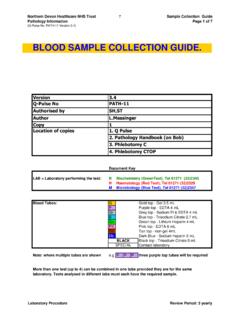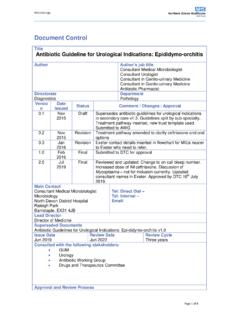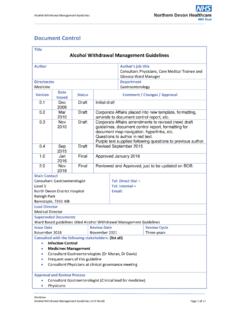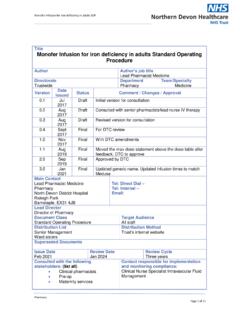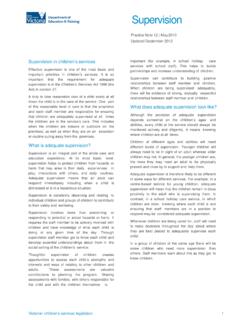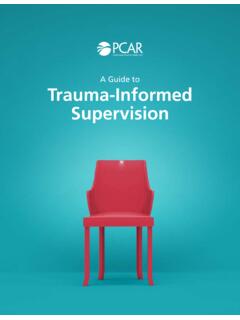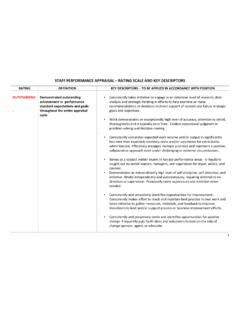Transcription of Supervision Guidance for Staff, Managers and Clinical ...
1 Supervision Guidance Booklet June 2018 Workforce Development Page 1 of 20 Supervision Guidance for staff , Managers and Clinical Supervisors Supervision is a process that promotes personal and professional development within a supportive relationship (Butterworth et al 1998). This Guidance is for all staff , Managers and Clinical supervisors. It relates to the Trust s Supervision Policy (2018) which you can find on the staff intranet. staff who are not Managers or supervisors need only read or print off pages 2, 3 and 4. Part 1: General information for everyone: What is Supervision ? How often should it happen? How can it be carried out? Who chooses the Clinical supervisor?
2 What is covered during Supervision ? What about Confidentiality? Part 2: Extra Information for Managers and Supervisors Responsibilities and training What is the role of the supervisor? Models of Supervision How is Supervision recorded? Guidance for Group Supervision Part 3: Templates for recording Supervision Example contract forms Example record forms Example review forms Supervision Guidance Booklet June 2018 Workforce Development Page 2 of 20 Part 1: General Information What is Supervision ? It is important for all staff to have Supervision , whatever their job role. This helps people to understand what is expected of them and to talk about how they are doing and any problems they face.
3 It also gives people the chance to talk through any topics related to their particular area of work so that they can continue to learn and keep up-to-date. Supervision is also important as a way of making sure that staff are working competently using good, safe practice and this helps us to provide high quality services and patient safety. The Trust recognises two main types of Supervision . If you have a non- Clinical role, you will only receive management Supervision . This is when a line manager meets with a member of staff to discuss workload and how the person is doing, share information, set work objectives and identify any issues that have come up in their day to day work. If you have a Clinical role you will also receive Clinical /Professional Supervision .
4 This is required as standard for certain staff who work in Clinical or professional roles. The Supervision is usually carried out by a trained supervisor who works in the same Clinical or professional field (such as nursing or therapy). If you have both management and Clinical Supervision it is quite possible you will have two different supervisors although sometimes it will be the same person. (NB Child Protection Supervision is provided separately for certain groups of staff ) How often should it happen? The minimum standard is once every 6 weeks. For some this will only be in the form of management Supervision , for others it may be a combination of this and Clinical Supervision . It includes appraisal and development reviews and all Supervision activity must be formally recorded.
5 How can Supervision be carried out? There are different ways that Supervision might take place. However it is important to note that if it is mainly done in groups or teams, staff have the right to ask for a one to one Supervision meeting when they feel that their needs are not being met. Here are some different ways that Supervision may take place: Supervision Guidance Booklet June 2018 Workforce Development Page 3 of 20 One to One Supervision : a private meeting between the supervisor and individual which could be for management or Clinical discussions. Team meetings or handovers: if these events are being counted as Supervision , they need to be recorded as such. It is important to note that any individual has the right to ask for a one to one session with their line manager or for Clinical Supervision should they feel they need it.
6 Group Supervision : This is usually used for Clinical Supervision . (See more details of this later in the document) Caseload/operational Supervision : where the workload, which may include Clinical cases, is allocated to a person, and is reviewed to assess progress, identify any issues, difficulties and good practice. Appraisal meetings: this is a formal annual review of performance and development by a line manager, nominated deputy or senior colleague and will take place at least annually for all staff . At least one interim review meeting should take place during the year to check the individual s progress towards their personal development plan. Other terms with the same meaning may be Individual performance review (IPR) or Development and review (D&R).
7 Whilst it is a form of managerial Supervision the frequency does constitute adequate Supervision . One to one peer Clinical Supervision (people in similar roles at the same level supporting each other professionally) Opportunistic Supervision : usually short unplanned meetings about specific Clinical and other learning opportunities that are useful to both manager and member of staff ) Who chooses the Clinical /professional supervisor? For Clinical Supervision it is your responsibility, with the help of your line manager, to find someone who works in your professional field and is a trained supervisor. Check that they have enough time to meet regularly with you and that you are near enough to find a meeting place convenient for both of you.
8 After an agreed length of time you will review the arrangements and contract with the supervisor, evaluating what is working well and how to improve the sessions. If you decided to change your supervisor, discuss it with them and your line manager giving reasons why. Supervision Guidance Booklet June 2018 Workforce Development Page 4 of 20 What is covered during Supervision ? Your supervisor s role is to provide you with support in your work, to help you develop and to ensure you understand the standards, policies etc. that the Trust sets. The key points of the discussion are recorded and you will receive a copy. Supervision records can be used by individuals as evidence for their appraisal.
9 What about Confidentiality? Both types of Supervision are treated as confidential. Sometimes it is useful to share information from Clinical Supervision with the line manager as there is a natural overlap between the two types. The person receiving Clinical Supervision will normally be expected to do this but if he/she refuses the supervisor must take professional responsibility for this. Notes of the Clinical supervisory activity and resulting action points should be available to the line manager when they can show reasonable concerns. There is a clear process for breaching confidentiality. Confidentiality may be breached if the Supervisee has: Performance issues Acted illegally Acted in such a manner which clearly constitutes a risk to patients and/or staff Clearly and seriously breached either Trust Policy and Procedure or professional and governing bodies codes of conduct including The Health Professions Council.
10 Identified safeguarding issues Management Supervision Clinical /Professional Supervision Workload Work issues Short/medium/long term objectives Personal development Personal issues affecting work a theme a specific issue problem or incident a specific area of practice case review/studies use of journal club as a focus for group discussion Supervision Guidance Booklet June 2018 Workforce Development Page 5 of 20 Part 2: Extra Information for Managers /Supervisors Responsibilities and training Managers are responsible for ensuring that all staff are regularly supervised by competent supervisors following the principles outlined in the policy. Processes for monitoring are now aligned with the e-appraisal system and staff undertaking appraisal are asked to confirm how frequently they are receiving Supervision and are asked to select one of four responses: 6 weekly ( in line with desired frequency of Supervision ) More than 6 weekly ( on a weekly or monthly basis) Less than 6 weekly ( quarterly) None ( do not consider they are receiving any form of Supervision ) This information will form the basis of a regular (anonymised) report of the frequency of Supervision across different parts of the organisation for monitoring purposes.



